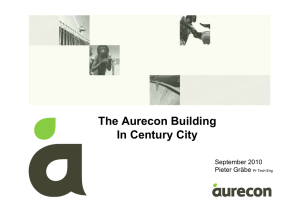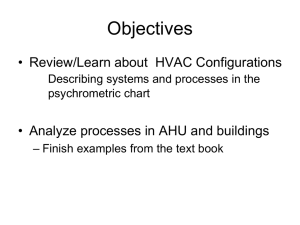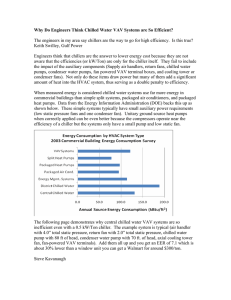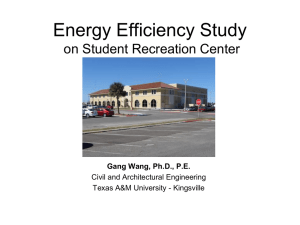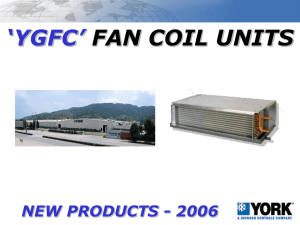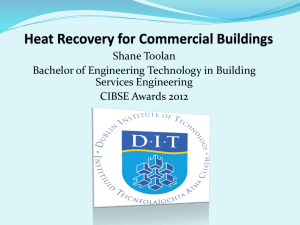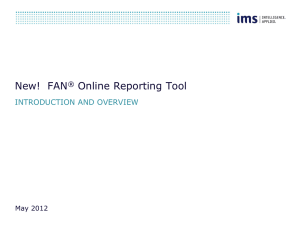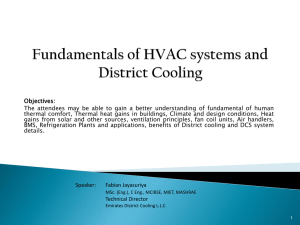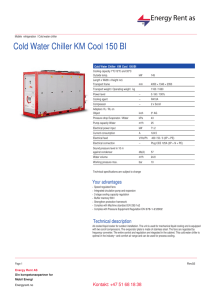leachwallace - Cashe
advertisement
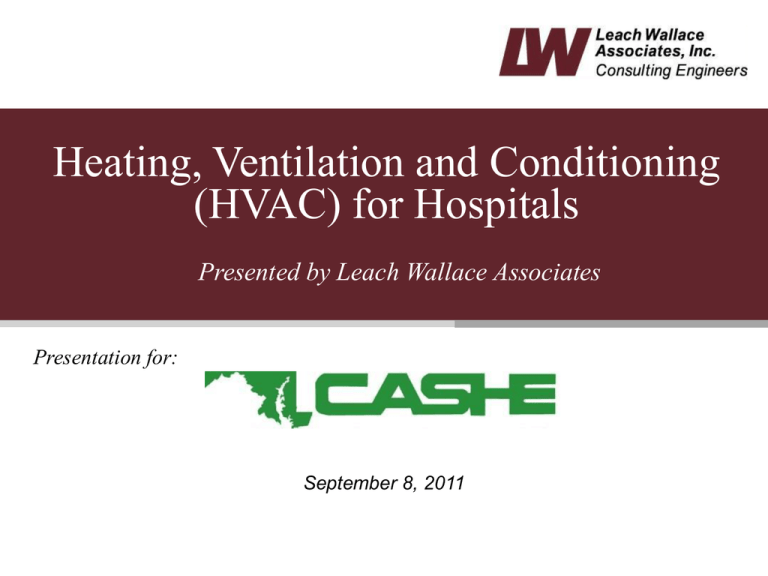
1 Heating, Ventilation and Conditioning (HVAC) for Hospitals Presented by Leach Wallace Associates Presentation for: September 8, 2011 Important Factors in the Selection of Hospital HVAC Systems ● First Cost ● Energy Efficiency / O&M Cost ● Maintainability ● Reliability ● Redundancy ● Flexibility: ● Change in Occupancy ● Partial Renovation ● Redundancy ● Controllability: ● Temperature ● Humidity ● Pressurization ● Air Quality ● Infection Control ● Sound and Vibration Traditional Hospital HVAC Systems Decentralized Systems ● Packaged Air Handling Units ● ● ● Local Special Systems ● ● ● Direct Expansion Chilled Water Medical Equipment Computer Rooms Terminal Units ● ● ● ● ● Unitary or Served by a Central Plant. Fan Coil Units Incremental Units Heat Pumps Induction Packaged Terminal Air Conditioner condenser fan supply fan compressor air-cooled condenser filter front grille cooling coil wall sleeve Water-Source Heat Pump refrigerant-to-air heat exchanger expansion device supply fan refrigerant-to-water heat exchanger compressor reversing valve Fan-Coil Unit filter supply-air outlet cooling coil supply fan return-air inlet Fan Coil Systems • 4 pipe • 2 pipe • Central ventilation unit Induction Units • 4 pipe • 2 pipe • Central ventilation unit Air-Cooled Chiller, Fan-Coil System dedicated outdoor-air unit fan-coil units exhaust fan air-cooled chiller system-level controller hot-water boiler pumps Small Chilled-Water System water chiller cooling coil pump control valve Rooftop VAV System packaged rooftop air conditioner system-level controller VAV terminals Traditional Hospital HVAC Systems Central Systems ● ● Could Still Utilize Unitary Equipment with All Air All Air Systems: ● ● ● ● Central Heating: ● ● Constant Volume Terminal Reheat Variable Air Volume Double Duct Boilers Central Cooling: ● Chillers Single Zone, Constant Volume EA OA RA cooling coil supply fan SA thermostat zone Multiple Zones, Constant Volume EA OA RA cooling coil supply fan SA reheat coil thermostat zone zone Multiple Zones, Variable Volume EA OA RA cooling coil supply fan SA VAV box thermostat zone zone multiple zones, variable volume VAV Terminal Units parallel fan-powered cooling only cooling with reheat series fan-powered multiple zones, variable volume Two-Fan, Dual-Duct VAV System cooling air handler OA PA dual-duct VAV terminal units heating air handler EA RA PA multiple zones, variable volume Dual-Duct VAV Terminal Unit warm primary air cool primary air supply air HVAC Filtration HEPA or tertiary filter Primary panel filter Secondary filter Pro’s and Con’s of Decentral and Central HVAC Systems Decentralized Centralized Installed Capacity Greater Lower First Cost Lower Higher O&M Cost Higher Lower Reliability Lower Higher Redundancy Little More Flexibility to Change Little More Controllability Poor to Good Good to Excellent Temperature Limited Excellent Humidity Limited Excellent Pressurization Limited Better Sound/Vibration Can be an Issue Better Infection Control Equipment Can be in Occupied Areas Much Better Sources of Chilled Water • Chilled water from a central plant • Chilled water from a single building chiller • Dedicated chiller for equipment or application Cooling Sources • Chiller Plant Constant or Variable Flow-Primary-Flow Systems variable-flow pumps check valves control valve two-way valve optional bypass with three-way valve Primary-Secondary Configuration production pumps distribution pump production loop distribution loop two-way valve Variable-Speed Drives variablespeed drive Boiler Plant • • • • Steam vs. Hot Water Fire tube vs. water tube Full size vs. Modular Hot Water Only What’s Changing Going Forward? ● LEED Requirements by the USGBC (Adoption by local authorities having jurisdiction) ● LEED for HealthCare What’s Changing Going Forward? ● ● ● ● ● ● Energy Conservation a significant part. Establishes ASHRAE 90.1 for base performance. LEED forces early consideration of all measures, considers tradeoffs, evaluates the building in total. Energy modeling required. ASHRAE Standard 189.2P ● High Performance Healthcare Facilities ● Issued for public review March 1, 2011. ● Goal for Publication, June 2012. FGI – Guidelines for Construction of Hospitals. ASHRAE Standard 90.1 - 2007 Energy standard for Buildings except low-rise Residential Buildings Purpose: To provide minimum requirements for the energy efficient design of building What does it apply to: ● New Building ● New portion of Buildings – Additions ● New Systems and Equipment in existing Buildings. ASHRAE Standard 90.1 – 2007 Continued… Compliance with Standard Option 1: Prescriptive Method – Comply with the specific provisions of each section. ● ● ● ● ● ● Building envelope requirements based on climate zones ● Ex. U-Values (Insulation) Heating ventilation and air conditioning – Equipment efficiency and sizing. Service water heating – Equipment efficiency recovery requirements. Power – limitations and efficiency in usages. Lighting – limitations and efficiency in usages. Other equipment. Option 2: Energy Cost Budget Method ● ● ● Energy Modeling Evaluate proposed system operation using simulation software versus base building system type. Energy use and costs comparison. Strategies to Reduce Energy Consumption ● ● ● ● ● ● ● Building Envelope Improvements Reduce Building Volume (Height) Reduce Fan Horsepower's. ● BIM as a resource. ● Requires less external static pressure. ● Larger ducts. ● Shorter horizontal duct runs. Moving away from traditional all air systems Dedicated ventilation air systems with exhaust heat recovery. Chiller ● Heat recovery Solar ● Hydronic ● PV Strategies to Reduce Energy Consumption Continued… ● Heat Recovery Chillers ● Using the rejected condenser heat ● Heat Pumps ● Heat Recovery ● Laundry ● Data Centers ● Ground Source Heat Pumps ● Cogeneration ● Trigeneration Ground-Source Heat-Pump System heat pump geothermal heat exchanger pumps Cogeneration Trigeneration Reduce Building Volume/Reduce Fan HP’s for All Systems ● Reducing building height and horizontal duct lengths. ● ● ● ● Requires more vertical duct risers. Careful design can accomplish this but the duct shifts are restricted to layout. Code requirements to limit fan HP’s are forcing non all air solutions. In spite of the advantages there are limits as to what can be accomplished without signification costs. Non All Air Systems ● ● ● ● Separate ventilation and dehumidification air systems to provide ventilation only. Local unitary equipment to accomplish sensible heating and cooling. All of these alternatives have drawbacks and risks. All provide less air delivery to control local pressurization. Ventilation- Energy Recovery Non All Air Alternatives ● Fan Coil Units ● Chilled Beams ● Positive Displacement Ventilation ● Hybrid VAV Systems Active Chilled Beams In Cooling and Heating Mode Passive Chilled Beams Active Chilled Beams Displacement Ventilation What To Do Today ● ● Optimize Central Plant Performance ● Boilers ● Chillers Controls, Maintenance, Calibration and Monitoring ● Commissioning ● Retro Commissioning ● LEED for Existing Buildings
